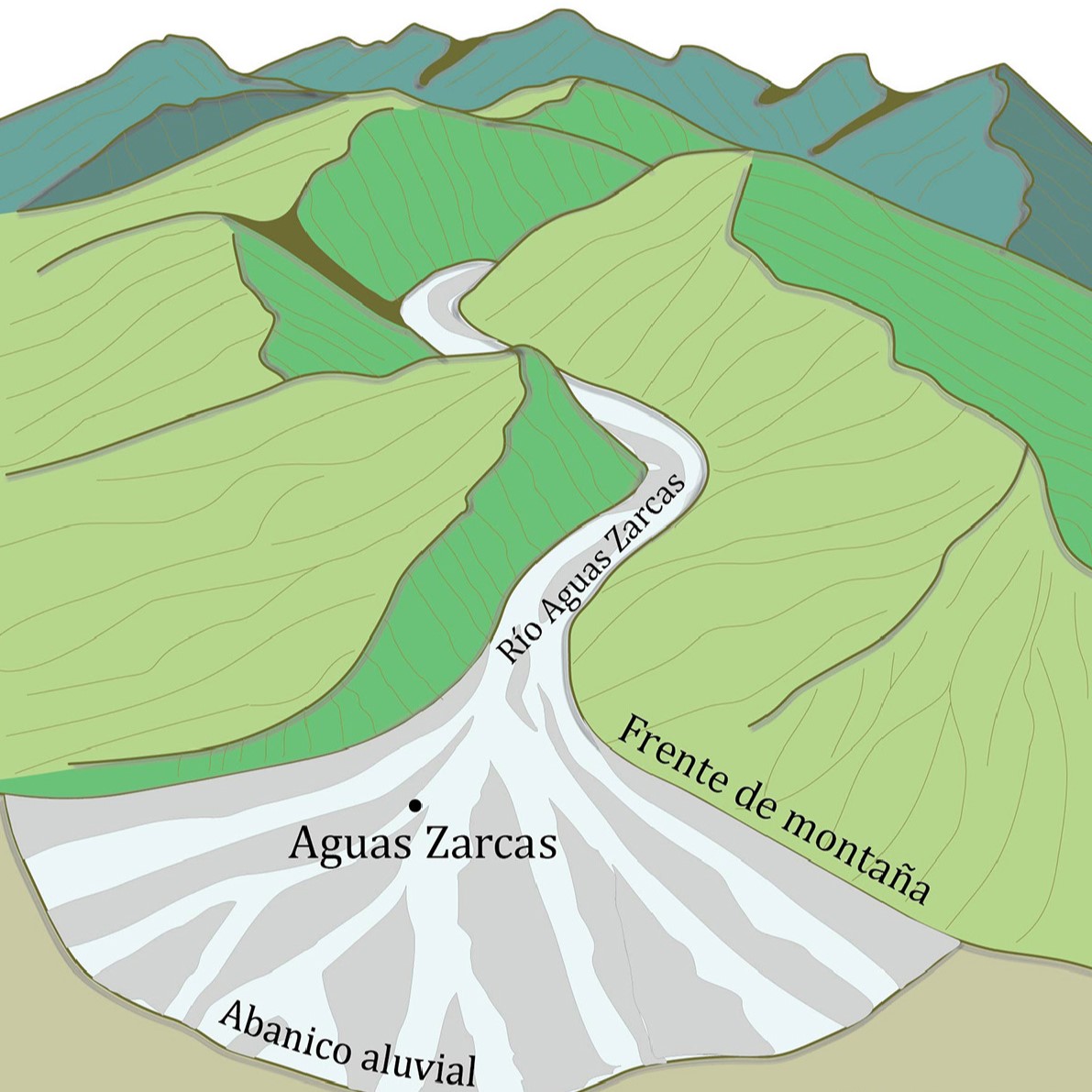Abstract
Alluvial fans are sedimentary forms typical of mountainous regions, where the flow of water loaded with sediments comes out of narrow canyons to wider and lower slope areas, depositing the sediments and forming fan-shaped structures. These fans can vary in activity, with some being very dynamic with frequent flooding and others more stable due to the geological configuration and tectonic processes. In the Bajada de Aguas Zarcas, located in the Aguas Zarcas District, Canton of San Carlos, Alajuela, Costa Rica, several coalescent alluvial fans were identified. Among these, the Aguas Zarcas River fan is the most extensive, followed by others such as the Aguas Zarcas paleo-river, the San Rafael River, and the Negritos River, among others. The morphology of these fans shows that sediments accumulate and spread, creating characteristic landforms. The composition of the fans in Aguas Zarcas varies from blocks of centimeter to metric dimensions in the proximal areas, to sandy strata and ash in the distal areas. Identification of active and inactive areas of these fans is crucial for assessing flood risk. Active areas are those where deposition and erosion are possible, and may be more prone to future flooding. The study included the use of geological and topographic maps, as well as field inspections to verify the activity of the fans. It was determined that the alluvial fans in the Bajada de Aguas Zarcas have been influenced by tectonic and volcanic processes, affecting the deposition and flow of sediments. This analysis provides a basis for risk management and sustainable development in flood-prone areas, highlighting the importance of understanding the sedimentary and geomorphological dynamics of alluvial fans.
References
Alfaro, A., Araya, M., Cambronero, L., Carmona, T., Cascante, A., Fernández, D., Gómez, C., Martínez, A., Montero, A., Murillo, F., Oviedo, J., Rodríguez, J.M., Santamaría, R., Sojo, D., Ureña, G., y Vargas, L. (2013). Informe geológico integral de una parte de la hoja topográfica Aguas Zarcas, escala 1:50000. [Campaña Geológica (G-5216)]. Universidad de Costa Rica, Facultad de Ciencias, Escuela Centroamericana de Geología.
Blissenbach, E. (1954). Geology of alluvial fans in semi-arid regions. Geological Society of America Bulletin, 65, 175-190.
Denny, C. S. (1965). Alluvial fans in the Death Valley region, California and Nevada. United States Geological Survey Professional Paper 466.
DeCelles, P. G., Gray, M. B., Ridgway, K. D., Cole, R. B., Pivnik, D. A., Pequera, N., y Srivastava, P. (1991). Controls on synorogenic alluvial-fan architecture, Beartooth Conglomerate (Palaeocene), Wyoming and Montana. Sedimentology, 38, 567-590.
Eckis, R. (1928). Alluvial fans in the Cucamonga District, Southern California. Journal of Geology, 36(3), 224-247.
Fairbridge, R.W. (1968). Geomorphology. Encyclopedia of Earth Science [Bajada, bahada (proluvium)]. Springer.
Federal Emergency Management Agency (FEMA). (2016). Guidance for Flood Risk Analysis and Mapping. Alluvial Fans. FEMA
Fernández, J., Bluck, B. J., y Viseras, C. (1993). The effects of fluctuating base level on the structure of alluvial fan and associated fan delta deposits: an example from the Tertiary of the Betic Cordillera, Spain. Sedimentology, 40, 879-893.
Harvey, A. M. (2018). Alluvial fans. Earth Systems and Environmental Sciences.
Jansson, P., Jacobson, D., y Le Hooke, R. B. (1993). Fan and playa areas in southern California and adjacent parts of Nevada. Earth Surface Processes and Landforms, 18(2), 109-119.
Jarquín-Sánchez, E. (2020). Conos piroclásticos de Aguas Zarcas: evidencia de la transición de un régimen magmático de arco a trasarco. [Tesis de licenciatura]. Universidad de Costa Rica.
Melton, M.A. (1965). The geomorphic and paleoclimatic significance of alluvial deposits in Southern Arizona. Journal of Geology 73, 1-38.
Merriam-Webster. (2023). In Merriam-Webster Dictionary [Alluvial fan]. https://www.merriam-webster.com/dictionary/alluvial%20fan
Okanagan Water Stewardship Council (OWSC). (2023). Okanagan alluvial fan hydrology: a primer. Okanagan Basin Water Board. https://www.obwb.ca/alluvial
U.S. Geological Survey (USGS). (2001). Natural hazards on alluvial fans: the debris flow and flash flood disaster of december 1999, Vargas State, Venezuela, FS 103 01, Guaynabo, PR. USGS.
Viseras, C., Calvache, M. L., Soria, J. M., y Fernández, J. (2003). Differential features of alluvial fans controlled by tectonic or eustatic accommodation space. Examples from the Betic Cordillera, Spain. Geomorphology, 50, 181-202.
##plugins.facebook.comentarios##

This work is licensed under a Creative Commons Attribution-NonCommercial-ShareAlike 4.0 International License.
Copyright (c) 2024 Rolando Mora Chinchilla






